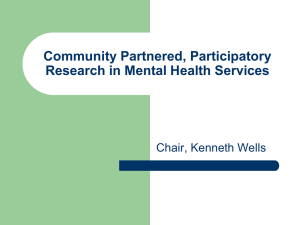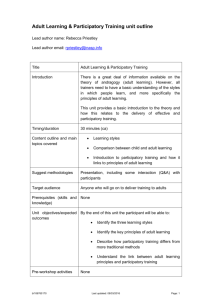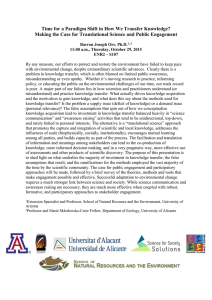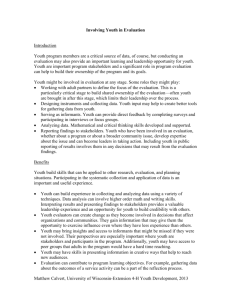Community Level Community-Level Interventions to Prevent or Manage Chronic Disease
advertisement
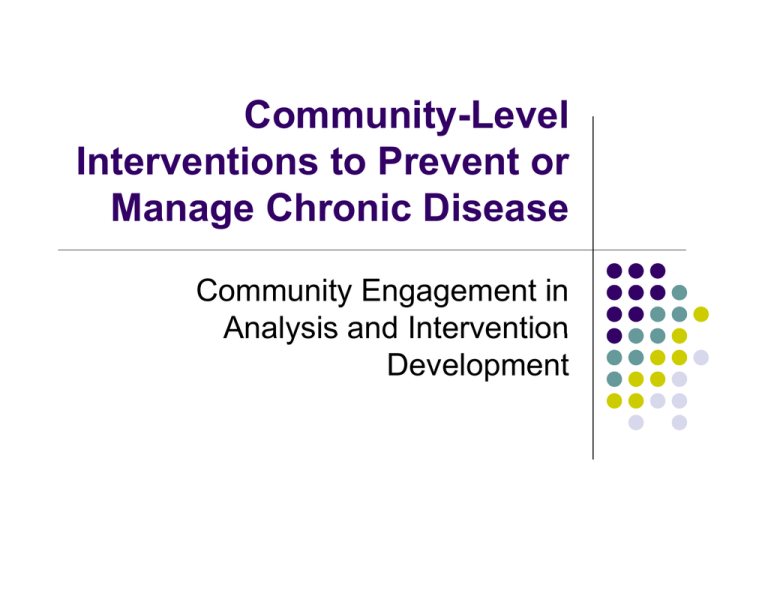
Community-Level Community Level Interventions to Prevent or Manage Chronic Disease Community Engagement in Analysis and Intervention Development Goal 1: Understand Community Health Issues Strategy gy 1D: Community y Forums & Communityy Partnered-Participatory Research 1 Town Hall 1. Status Identify Public Health problem Complete Convene Conference for Knowledge Exchange Data and Collection Complete Analyses: Pile Sorting, Multidimensional Scaling and Cluster Analysis Complete Feedback and Dissemination: Forums, publications and presentations 2nd Town Hall July 2010 Summer/Fall 2010 Translational Research in the 21st Century y Interdisciplinary Research Public-Private Partnerships Bench Building Blocks and Pathways Molecular Libraries Bi i f Bioinformatics ti and d Computational Biology Structural Biology N Nanomedicine di i Bedside Community & Public Health Practice Clinical Research/Trials & Training “Practical” Trials Bio-behavioral/Cultural Bio behavioral/Cultural Community Partnered Participatory Research System Level Clinical Outcomes Assessment Geographic Systems Modeling H lth Advocacy Health Ad &P Policy li Norris KC, Ethnicity & Disease, 2005 Fi di Finding Answers A to t Disparities Di iti Document Disparities and Causes Develop l andd Test Interventions Intervention design Practical trials Implement Solutions Efficiently Di Disparities iti IIntervention t ti D Design i Conceptual Model Use culturally and linguistically appropriate media, di settings, tti and d agents t Incorporate patient and community input at all stages t off research h Use multifaceted, intensive, and interactive approaches h Cooper LA, J Gen Intern Med, 2002 Community-Based Participatory Research Community-Based Community Based Participatory Research (CBPR) model “a collaborative approach to research that equitably involves all partners in the research process and recognizes the unique strengths that each brings” brings Wallerstein N, Ethn Dis 2006 Community “Partnered” Participatory Research Community-“Partnered” Community Partnered Participatory Research (CPPR) to maintain an equitable and highly engaged partnership that recognizes and respects each partner, yet clearly distinguished from CBPR to minimize false expectations and potential conflicts Wells K, Ethn Dis, 2006 Community-“Partnered” Participatory Research “Many Many components of Community Community-Partnered Partnered Participatory Research (CPPR) are partly based on Community-Based Participatory Research (CBPR) models but are organized into a particular approach” approach Jones L, JAMA, 2007 Community- Partnered Participatory Research 1 1. 2. 3 3. 4. Identify a health issue that fits community priorities and academic capacity to respond Developing a coalition of community, policy and academic stakeholders that informs supports, shares and uses the products Engaging the community through conferences and workshops that provide information, determine readiness to proceed and obtain input Initiate work groups that develop, implement, and evaluate action plans Jones L, JAMA, 2007 Community- Partnered Participatory Research 1 1. 2. 3 3. 4. Identify a health issue that fits community priorities and academic capacity to respond Developing a coalition of community, policy and academic stakeholders that informs supports, shares and uses the products Engaging the community through conferences and workshops that provide information, determine readiness to proceed and obtain input Initiate work groups that develop, implement, and evaluate action plans Jones L, JAMA, 2007 Aims Ai Use CPPR to reduce to Health Disparities in South Los Angeles Short term term-Create Create Los Angeles health collaborative that can have an impact on disparities p locally y and nationally y Long Term-Carry out CPPR project including community members at every stage of project and disseminate approach and findings M th d Methods Community Town Hall Discussions 56 Community members who responded to fliers at LA Urban League community events within 70 block area Eight Roundtables, two conducted in Spanish Four F collaboratively ll b ti l d developed l d questions ti posed d Partnered Analysis 3 Academics Academics, 3 Urban League staff and 3 Community members Four meetings: Pile sorting and Cluster Interpretation Goal 1: Understand community health issues Strategy 1D: Community forums Community Partnered-Participatory Research Responses Themes 1.What is the main challenge to better health in your community? 124 40 2.Community strengths or assets that can be used to address these challenges? 150 35 3.What can we do working together to improve the health of the community? 169 60 77 29 Question 4. What should our message be? M th d Methods Qualitative and Quantitative Analyses Theme identification Pile Sorting g #1- Conference responses p Group discussion and consensus building Theme sorting Pile Sorting #2- How are themes related? Multi-Dimensional Scaling (MDS) Borgatti, g , Visual AnthroPac 2003© Natick MA Interpretation of MDS cluster results M th d Methods Multidimensional Scaling (MDS) and Stress Evaluation How similar or dissimilar are themes to each other? How many times they were put into same pile? Spatial description of how similar answers are? AnthroPac © Natick MA If the stress score is too high it will be hard to make a good picture, and there will be a lot of “Stress” (more th .2 than 2 iis ttoo much) h) If the stress is greater than .2 then the picture is not doing a very good job at telling the story of the answers. Sturrock and Rocha, Field Methods, 2000 Goal 1: Understand community health issues Strategy 1D: Community forums Community Partnered-Participatory Research Responses Themes Multi-Dimensional Scaling & Cluster Interpretation 1.What is the main challenge to better health in your community? 124 40 5 2.Community strengths or assets that can be used to address these challenges? 150 35 4 3.What can we do working together to improve the health of the community? 169 60 5 77 29 5 Question 4. What should our message be? Neighborhood and Built Environment Deprivation Lack of collective awareness and trust Barriers to healthy behavior changes Poor access to and quality of health care Perceived P i d and d realized lack of access to healthy foods 1: From your perspective, what is the main challenge h ll tto b better tt h health lth iin your community? it ? Neighborhood and Built Environment Deprivation Lack of collective awareness and trust Cost of Medical Care, Profit Motive in Health Care Perceived and realized lack of access to healthyy foods Sense of Community, Mistrust of Politicians/ Community Leaders/ Systems P Poor access to t and d quality lit off h health lth care Health Prevention Resources/Availability of Healthy Resources, Drug Dealing/ Addicts / Drugs in Community High cost of healthy food, Poor Access to Healthy Food Barriers to healthy behavior changes Community Health Beliefs; Self Self-empowerment; empowerment; Lack of Knowledge; Stress Summary Incorporate community input at every level Objective/open inclusion process Continuous feedback & dissemination Develop partnered interventions and programs Implementation and evaluation Goal 2: Engage L.A. community Strategy 2B: Identify & develop community-partnered interventions Interventions Status 1. Existing Urban League Interventions 1. Deputy Neighborhood office initiated programs 2. Health Collaborative Ideas/Comments 2. Collaborative meetings and feedback sessions 3. Community Ideas and Comments 3. Findings from CommunityPartnered Participatory Research and Focus Groups
